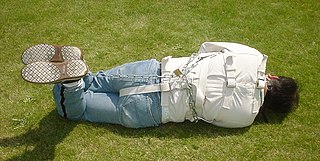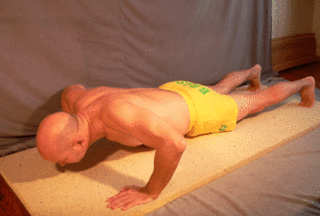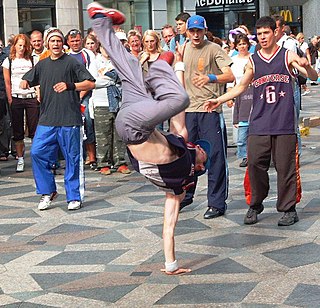Related Research Articles

Zanni, Zani or Zane is a character type of commedia dell'arte best known as an astute servant and a trickster. The Zanni comes from the countryside and is known to be a "dispossessed immigrant worker". Through time, the Zanni grew to be a popular figure who was first seen in commedia as early as the 14th century. The English word zany derives from this person. The longer the nose on the characters mask the more foolish the character.

A straitjacket is a garment shaped like a jacket with long sleeves that surpass the tips of the wearer's fingers. Its most typical use is restraining people who may cause harm to themselves or others. Once the wearer slides their arms into the sleeves, the person restraining the wearer crosses the sleeves against the chest and ties the ends of the sleeves to the back of the jacket, ensuring the arms are close to the chest with as little movement as possible.

In partner dancing, closed position is a category of positions in which partners hold each other while facing at least approximately toward each other.

The bench press, or chest press, is a weight training exercise in which the trainee presses a weight upwards while lying on a weight training bench. Although the bench press is a full-body exercise, the muscles primarily used are the pectoralis major, the anterior deltoids, and the triceps, among other stabilizing muscles. A barbell is generally used to hold the weight, but a pair of dumbbells can also be used.

The push-up is a common calisthenics exercise beginning from the prone position. By raising and lowering the body using the arms, push-ups exercise the pectoral muscles, triceps, and anterior deltoids, with ancillary benefits to the rest of the deltoids, serratus anterior, coracobrachialis and the midsection as a whole. Push-ups are a basic exercise used in civilian athletic training or physical education and commonly in military physical training. They are also a common form of punishment used in the military, school sport, and some martial arts disciplines.

Arm wrestling is a sport with two opponents who face each other with their bent elbows placed on a table and hands firmly gripped, who then attempt to force the opponent's hand down to the table top. The sport is often casually used to demonstrate the stronger person between two or more people.
Juggling practice has developed a wide range of patterns and forms which involve different types of manipulation, different props, numbers of props, and numbers of jugglers. The forms of juggling shown here are practiced by amateur, non-performing, hobby jugglers as well as by professional jugglers. The variations of juggling shown here are extensive but not exhaustive as juggling practice develops and creates new patterns on a regular basis. Jugglers do not consciously isolate their juggling into one of the categories shown; instead most jugglers will practice two or more forms, combining the varieties of juggling practice. Some forms are commonly mixed, for example: numbers and patterns with balls; while others are rarely mixed, for example: contact numbers passing. Many Western jugglers also practice other forms of object manipulation, such as diabolo, devil sticks, cigar box manipulation, fire-spinning, contact juggling, hat manipulation, poi, staff-spinning, balancing tricks, bar flair and general circus skills.
The snatch is the first of two lifts contested in the sport of weightlifting followed by the clean and jerk. The objective of the snatch is to lift the barbell from the ground to overhead in one continuous motion. There are four main styles of snatch used: snatch, split snatch, power snatch, and muscle snatch. The full lift is the most common style used in competition, while power snatches and muscle snatches are mostly used for training purposes, and split snatches are rarely used. Any of these lifts can be performed from the floor, from the hang position, or from blocks. In competition, only lifts from the floor are allowed.
Out of This World is a card trick created by magician Paul Curry in 1942, in which an audience member is asked to sort a deck into piles of red and black cards, without looking at the faces. Many performers have devised their own variations of this trick. It is often billed as "the trick that fooled Winston Churchill" due to a story describing how it was performed for him during World War II. The method behind the trick is simple and essentially self-working, and can be enhanced by the presentation of the performer and the use of other principles of magic.

Thomas Nelson Downs was a manipulative magicians known for his coin tricks. Downs was also known as "The King of Koins".

The rear naked choke (RNC) is a chokehold in martial arts applied from an opponent's back. The word "naked" in this context suggests that, unlike other strangulation techniques found in jujutsu/judo, this hold does not require the use of a keikogi ("gi") or training uniform.

In weight training, a kettlebell is a cast-iron or cast-steel ball with a handle attached to the top. It is used to perform many types of exercises, including ballistic exercises that combine cardiovascular, strength and flexibility training. Kettlebells are the primary equipment used in the weight-lifting sport of kettlebell lifting.
An armlock in grappling is a single or double joint lock that hyperextends, hyperflexes or hyperrotates the elbow joint or shoulder joint. An armlock that hyper-extends the arm is known as an armbar, and it includes the traditional armbar, pressing their elbow into your thigh, and the triangle armbar, like a triangle choke, but you press their elbow into your thigh. An armlock that hyper-rotates the arm is known as an armcoil, and includes the americana, kimura, and omaplata. Depending on the joint flexibility of a person, armcoils can either hyper-rotate only the shoulder joint, only the elbow joint, or both the elbow joint and shoulder joint. Generally, armcoils hurt more than armbars, as they attack several joints at the bone and muscle.
This is a glossary of conjuring terms used by magicians.

A freeze is a b-boying technique that involves halting all body motion, often in an interesting or balance-intensive position. It is implied that the position is hit and held from motion as if freezing in motion, or into ice. Freezes often incorporate various twists and distortions of the body into stylish and often difficult positions.

Static trapeze, also known as fixed trapeze, is a type of circus art performed on the trapeze. In contrast to the other forms of trapeze, on static trapeze the bars and ropes mainly stay in place.

Robert L. Bednarski was an American heavyweight weightlifter. He set 12 world record in 1968–69 and won three medals at the world championships, including a gold in 1969.

A juggling pattern or juggling trick is a specific manipulation of props during the practice of juggling. "Juggling, like music, combines abstract patterns and mind-body coordination in a pleasing way." Descriptions of patterns and tricks have been most common in toss juggling. A juggling pattern in toss juggling is a sequence of throws and catches using a certain number of props which is repeated continuously. Patterns include simple ones such as the cascade and complex ones such as Mills mess. A juggling trick in toss juggling is a throw or catch which is different from the throws and catches within a pattern. Tricks include simple ones such as a high throw or more difficult ones such a catch on the back of the jugglers neck, as well as the claw, multiplex, and pass. Systems of juggling notation have been created to describe juggling patterns and tricks. One of these is siteswap notation.
The binasuan is a Filipino folk dance in which the performer holds full wine glasses in each hand while performing balancing tricks. Wine may be used to fill the glasses, but other liquids may be substituted. The arms are rotated over and under the shoulder in order to keep the palms facing up so as not to spill the liquid while nevertheless allowing the radius to cross over the ulna via pronation. Binasuan originated in Pangasinan and is popular at festive events such as weddings.

Kettlebell Sport lifting a.k.a. Girya is a repetitive weight lifting sport performed with kettlebells in a given period of time.